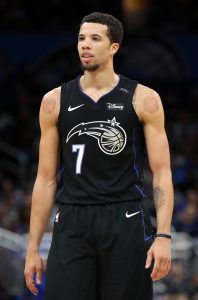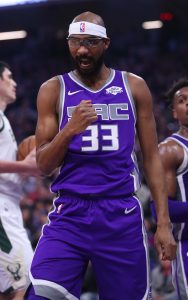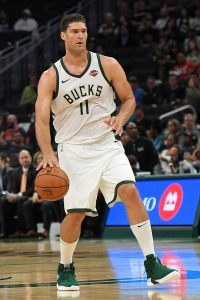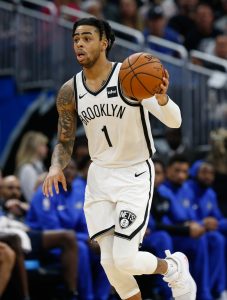The NCAA rule changes related to early entrants for the NBA draft, initially instituted in 2016, remain in effect this year. Those rule changes will allow underclassmen to “test the waters” before officially committing to the 2019 NBA draft.
However, those rules come with a new twist this time around — for the first time, NCAA underclassmen will be permitted to formally hire representation without forgoing their remaining college eligibility. As the NCAA explains in a memo, relayed by ESPN’s Jonathan Givony, there are a handful of rules that players must follow throughout the process to maintain their eligibility, but it’s still the first time that prospects will be permitted to be represented by an agent without losing that eligibility.
NCAA underclassmen have until the end of the day on April 21 to declare for the draft, and can withdraw at any time up until May 29 while maintaining their college eligibility. That means that prospects testing the waters can take part in the NBA draft combine from May 14-19 – if invited – and can work out for individual teams starting later this month. Meanwhile, the NBA’s only withdrawal deadline is on June 10 at 4:00pm CT, so international early entrants will have until then to decide whether or not to remain in the draft.
A year ago, the NBA’s initial list of early entrants included a record 236 names, but many of those players eventually withdrew from consideration prior to the May and June deadlines. This year, the final draft list will be set after the early entrant withdrawal deadline for international and other non-NCAA players passes on June 10.
In the meantime, we’ll use this post to keep track of reports and announcements on early entrant prospects and their decisions. We’ll archive them all in a running list here, which will be accessible anytime under “Hoops Rumors Features” on the right sidebar of our desktop site, or in the “Features” page found in our mobile menu.
The players below are listed in alphabetical order. If you have any corrections or omissions, please contact us.
Last updated 6-11-19 (9:10pm CT)
College Underclassmen:
Stayed in draft:
- Nickeil Alexander-Walker, G, Virginia Tech (sophomore)
- R.J. Barrett, G/F, Duke (freshman)
- Tyus Battle, G, Syracuse (junior)
- Darius Bazley, F, Princeton HS (OH) (N/A)
- Bol Bol, C, Oregon (freshman)
- Marques Bolden, C, Duke (junior)
- Jordan Bone, G, Tennessee (junior)
- Ky Bowman, G, Boston College (junior)
- Ignas Brazdeikis, F, Michigan (freshman)
- Oshae Brissett, F, Syracuse (sophomore)
- Armoni Brooks, G, Houston (junior)
- Charlie Brown, G, St. Joseph’s (sophomore)
- Moses Brown, C, UCLA (freshman)
- Brandon Clarke, F, Gonzaga (junior)
- Nicolas Claxton, F, Georgia (sophomore)
- Amir Coffey, G, Minnesota (junior)
- Tyler Cook, F, Iowa (junior)
- Jarrett Culver, G/F, Texas Tech (sophomore)
- Aubrey Dawkins, G, UCF (junior)
- Luguentz Dort, G, Arizona State (freshman)
- Jason Draggs, F, Lee College (TX) (freshman)
- Carsen Edwards, G, Purdue (junior)
- Bruno Fernando, F, Maryland (sophomore)
- Daniel Gafford, F/C, Arkansas (sophomore)
- Darius Garland, G, Vanderbilt (freshman)
- Kyle Guy, G, Virginia (junior)
- Rui Hachimura, F, Gonzaga (junior)
- Jaylen Hands, G, UCLA (sophomore)
- Jared Harper, G, Auburn (junior)
- Jaxson Hayes, F/C, Texas (freshman)
- Dewan Hernandez, F, Miami (junior)
- Tyler Herro, G, Kentucky (freshman)
- Amir Hinton, G, Shaw (junior)
- Jaylen Hoard, F, Wake Forest (freshman)
- Daulton Hommes, F, Point Loma Nazarene University (junior)
- Talen Horton-Tucker, G, Iowa State (freshman)
- De’Andre Hunter, F, Virginia (sophomore)
- Ty Jerome, G, Virginia (junior)
- Keldon Johnson, F, Kentucky (freshman)
- Mfiondu Kabengele, C, Florida State (sophomore)
- Louis King, F, Oregon (freshman)
- V.J. King, F, Louisville (junior)
- Sagaba Konate, F, West Virginia (junior)
- Martin Krampelj, F, Creighton (junior)
- Romeo Langford, G, Indiana (freshman)
- Cameron Lard, F, Iowa State (sophomore)
- Dedric Lawson, F, Kansas (junior)
- Jalen Lecque, G, Brewster Academy (NH) (N/A)
- Jacob Ledoux, G, UTPB (junior)
- Nassir Little, F, UNC (freshman)
- Trevor Manuel, F, Olivet (MI) (junior)
- Charles Matthews, G, Michigan (junior)
- Jalen McDaniels, F, San Diego State (sophomore)
- Ja Morant, G, Murray State (sophomore)
- Zach Norvell Jr., G, Gonzaga (sophomore)
- Jaylen Nowell, G, Washington (sophomore)
- Chuma Okeke, F, Auburn (sophomore)
- KZ Okpala, F, Stanford (sophomore)
- Miye Oni, G/F, Yale (junior)
- Lamar Peters, G, Mississippi State (junior)
- Shamorie Ponds, G, St. John’s (junior)
- Jordan Poole, G, Michigan (sophomore)
- Jontay Porter, F, Missouri (sophomore)
- Kevin Porter Jr, G, USC (freshman)
- Brandon Randolph, G, Arizona (sophomore)
- Cam Reddish, F, Duke (freshman)
- Isaiah Reese, G, Canisius (junior)
- Naz Reid, C, LSU (freshman)
- Austin Robinson, G, Kentucky Christian (sophomore)
- Isaiah Roby, F, Nebraska (junior)
- Ayinde Russell, G, Morehouse (junior)
- Samir Sehic, F, Tulane (junior)
- Simisola Shittu, F, Vanderbilt (freshman)
- Justin Simon, G, St. John’s (junior)
- D’Marcus Simonds, G, Georgia State (junior)
- Jalen Sykes, F, St. Clair College (Canada) (junior)
- Rayjon Tucker, G, Little Rock (junior)
- Nick Ward, F, Michigan State (junior)
- P.J. Washington, F, Kentucky (sophomore)
- Tremont Waters, G, LSU (sophomore)
- Coby White, G, UNC (freshman)
- Lindell Wigginton, G, Iowa State (sophomore)
- Kris Wilkes, G, UCLA (sophomore)
- Grant Williams, F, Tennessee (junior)
- Zion Williamson, F, Duke (freshman)
- Kenny Wooten, F, Oregon (sophomore)
Withdrew from draft after testing the draft waters:
- Milan Acquaah, G, California Baptist (sophomore)
- Bryce Aiken, G, Harvard (junior)
- Wajid Aminu, F, North Florida (junior)
- Desmond Bane, G, TCU (junior)
- Charles Bassey, C, Western Kentucky (freshman)
- Troy Baxter Jr., F, Florida Gulf Coast (sophomore)
- Kerry Blackshear Jr., F, Virginia Tech (junior)
- Phil Bledsoe, F, Glenville State (junior)
- DaQuan Bracey, G, Louisiana Tech (junior)
- Keith Braxton, G, St. Francis (PA) (junior)
- Nico Carvacho, C, Colorado State (junior)
- Yoeli Childs, F, BYU (junior)
- R.J. Cole, G, Howard (sophomore)
- Anthony Cowan, G, Maryland (junior)
- Jarron Cumberland, G, Cincinnati (junior)
- Tulio Da Silva, F, Missouri State (junior)
- Caleb Daniels, G, Tulane (sophomore)
- Silvio De Sousa, F, Kansas (sophomore)
- Javin DeLaurier, F, Duke (junior)
- Mamadi Diakite, F, Virginia (forward)
- Alpha Diallo, G, Providence (junior)
- James Dickey, F, UNC Greensboro (junior)
- David DiLeo, F, Central Michigan (junior)
- Davon Dillard, G, Shaw (NC) (junior)
- Devon Dotson, G, Kansas (freshman)
- Aljami Durham, G, Indiana (sophomore)
- C.J. Elleby, F, Washington State (freshman)
- Steven Enoch, C, Louisville (junior)
- Jaylen Fisher, G, TCU (junior)
- Savion Flagg, G, Texas A&M (sophomore)
- Eugene German, G, Northern Illinois (junior)
- TJ Gibbs, G, Notre Dame (junior)
- Quentin Goodin, G, Xavier (junior)
- Tony Goodwin II, G/F, Redemption Christian Academy (N/A)
- Kellan Grady, G, Davidson (sophomore)
- Devonte Green, G, Indiana (junior)
- Quentin Grimes, G, Kansas (freshman)
- Jon Axel Gudmundsson, G, Davidson (junior)
- Jerrick Harding, G, Weber State (junior)
- Kevon Harris, G, Stephen F. Austin (junior)
- Jayce Johnson, C, Utah (junior)
- Markell Johnson, G, North Carolina State (junior)
- Tyrique Jones, F, Xavier (junior)
- Sacha Killeya-Jones, F, North Carolina State (junior)
- Nathan Knight, F, William & Mary (junior)
- Anthony Lamb, F, Vermont (junior)
- A.J. Lawson, G, South Carolina (freshman)
- Tevin Mack, G, Alabama (junior)
- Malik Maitland, G, Bethune-Cookman (junior)
- Jermaine Marrow, G, Hampton (junior)
- Naji Marshall, F, Xavier (sophomore)
- Skylar Mays, G, LSU (junior)
- Davion Mintz, G, Creighton (junior)
- EJ Montgomery, F, Kentucky (freshman)
- Andrew Nembhard, G, Florida (freshman)
- Kouat Noi, F, TCU (sophomore)
- Joel Ntambwe, F, UNLV (freshman)
- Jordan Nwora, F, Louisville (sophomore)
- Devonte Patterson, F, Prairie View A&M (junior)
- Reggie Perry, F, Mississippi State (freshman)
- Filip Petrusev, F, Gonzaga (freshman)
- Jalen Pickett, G, Siena (freshman)
- Cletrell Pope, F, Bethune-Cookman (junior)
- Nik Popovic, F, Boston College (junior)
- Myles Powell, G, Seton Hall (junior)
- Payton Pritchard, G, Oregon (junior)
- Neemias Queta, C, Utah State (freshman)
- Nick Richards, F, Kentucky (sophomore)
- Laquincy Rideau, G, South Florida (junior)
- Kevin Samuel, C, TCU (freshman)
- Paul Scruggs, G, Xavier (sophomore)
- Josh Sharkey, G, Samford (junior)
- Nike Sibande, G, Miami (OH) (sophomore)
- Javonte Smart, G, LSU (freshman)
- Justin Smith, F, Indiana (sophomore)
- Derrik Smits, C, Butler (junior)
- Xavier Sneed, F, Kansas State (junior)
- Lamar Stevens, F, Penn State (junior)
- Marlon Taylor, G, LSU (junior)
- Ethan Thompson, G, Oregon State (sophomore)
- Killian Tillie, F, Gonzaga (junior)
- Donnie Tillman, F, Utah (sophomore)
- Tres Tinkle, F, Oregon State (junior)
- Obi Toppin, F, Dayton (freshman)
- Justin Turner, G, Bowling Green (sophomore)
- Kaleb Wesson, F, Ohio State (sophomore)
- Jimmy Whitt, G, SMU (junior)
- Joe Wieskamp, G, Iowa (freshman)
- Charles Williams Jr., G, Howard (junior)
- Emmitt Williams, F, LSU (freshman)
- Holland Woods, G, Portland State (sophomore)
International Early Entrants:
Stayed in draft:
- Goga Bitadze, C, Georgia (born 1999)
- Yago Mateus Dos Santos, G, Brazil (born 1999)
- Sekou Doumbouya, F, France (born 2000)
- Matas Jogela, G, Lithiuania (born 1998)
- Marcos Louzada Silva, G/F, Brazil (born 1999)
- William McDowell-White, G, Germany (born 1998)
- Adam Mokoka, G, France (born 1998)
- Joshua Obiesie, G, Germany (born 2000)
- David Okeke, F, Italy (born 1998)
- Luka Samanic, F, Croatia (born 2000)
- Deividas Sirvydis, G, Lithuania (born 2000)
- Yovel Zoosman, G/F, Israel (born 1998)
Withdrew from draft after testing the waters:
- Dikembe Andre, C, Brazil (born 1999)
- Darko Bajo, F, Croatia (born 1999)
- Aleksander Balcerowski, C, Poland (born 2000)
- Vrenz Bleijenbergh, F, Belgium (born 2000)
- Adrian Bogucki, C, Poland (born 1999)
- Leandro Bolmaro, G, Argentina (born 2000)
- Ognjen Carapic, G, Montenegro (born 1998)
- Kevin Cham, G, France (born 1998)
- Leo Cizmic, F, Croatia (born 1998)
- Digue Diawara, F, France (born 1998)
- Nenad Dimitrijevic, G, Macedonia (born 1998)
- Felipe Dos Anjos, C, Brazil (born 1998)
- Henri Drell, F, France (born 2000)
- Paul Eboua, F, Cameroon (born 2000)
- Osas Ehigiator, C, Spain (born 1999)
- Biram Faye, F, Senegal (born 2000)
- Ivan Fevrier, F, France (born 1999)
- Aleix Font, G/F, Spain (born 1998)
- Philipp Herkenhoff, F, Germany (born 1999)
- Dalibor Ilic, F, Bosnia (born 2000)
- Panagiotis Kalaitzakis, G/F, Greece (born 1999)
- Mate Kalajzic, G, Croatia (born 1998)
- Lukasz Kolenda, G, Poland (born 1999)
- Andrija Marjanovic, G/F, Serbia (born 1999)
- Gytis Masiulis, F/C, Lithuania (born 1998)
- Jonas Mattisseck, G, Germany (born 2000)
- Nikita Mikhailovskii, G/F, Russia (born 2000)
- Nikola Miskovic, F, Serbia (born 1999)
- Muhaymin Mustafa, G, Turkey (born 1999)
- Abdoulaye N’doye, G, France (born 1998)
- Toni Nakic, G, Croatia (born 1999)
- Tanor Ngom, C, Senegal (born 1998)
- Louis Olinde, G/F, Germany (born 1998)
- Zoran Paunovic, G, Serbia (born 2000)
- Dino Radoncic, F, Montenegro (born 1999)
- Sander Raieste, F, Estonia (born 1999)
- Neal Sako, C, France (born 1998)
- Tadas Sedekerskis, F, Lithuania (born 1998)
- Njegos Sikiras, F, Bosnia (born 1999)
- Borisa Simanic, F, Serbia (born 1998)
- Khadim Sow, C, Senegal (born 1999)
- Filip Stanic, F/C, Germany (born 1998)
- Michael Uchendu, C, Brazil (born 1998)
- Bastien Vautier, C, France (born 1998)
- Arnas Velicka, G, Lithuania (born 1999)
- Warren Woghiren, C, France (born 1998)
- Arturs Zagars, G, Latvia (born 2000)


 Tyus Jones
Tyus Jones

